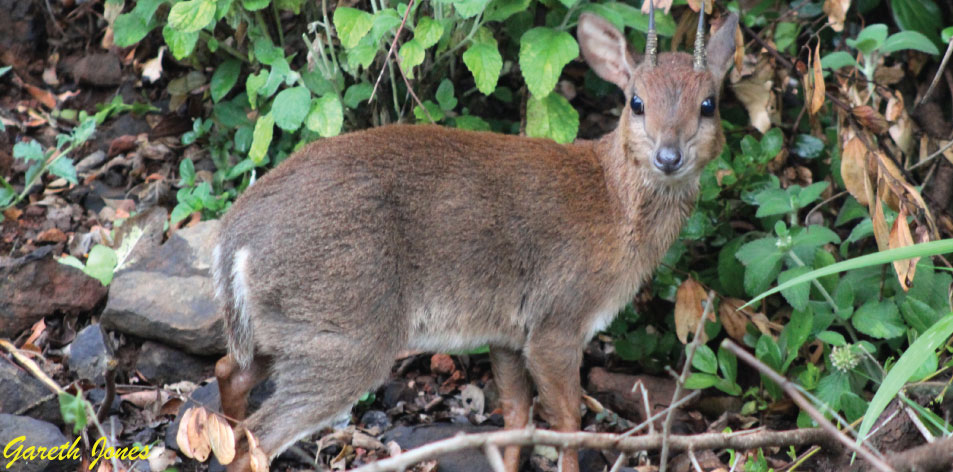
The Tiny Suni!!!- Article by Gareth Jones
The Tiny Suni Of The Nairobi National Park
While driving on the tar road towards the main gate in the late afternoon, I saw a tiny antelope eating next to the road. It was a tiny Suni, only found in the forested section, and can be seen if driving very slowly, when they feed on green shoots and leaves. They are very shy and sensitive, and it is rare to get close to them.
The suni suddenly ran across the road, and went into a thick clump of bushes, I was just about to drive onward, when suddenly the suni emerged from the bushes. I could scarcely believe my eyes, a tiny, minute little newborn lamb was trying to stand and suckle on its mother. WOW! What a wonderful super suni sighting, a mega tick on my all-time sightings in the park. The lamb could not have been more than an hour or two old, and the mother was trying to force it to walk, as she slowly moved away every time the lamb tried to stand and walk on its wobbly newborn legs. There is always something very precious and special about witnessing the start of a new life.
Nairobi park is amazing in this way, for having the largest antelope the eland, to one of the smallest the suni.
Suni are often mistaken for Dik-dik, the tiny antelope seen in the forest area are almost always Suni (Nesotragus moschatus) also known as “Paa’ in Kiswahili, even smaller than dik-dik, they are the smallest antelope in the park. They vary in colour from fawn grey to chestnut brown on the back with white underneath. It occurs in dense underbrush from central Kenya to KwaZulu-Natal in South Africa.
Suni are around 30 to 43 centimetres high at the shoulder and weigh 4.5 to 5.4 kilograms. Males have horns 8–13 cm long, that are ridged most of their length and curve backwards close to their heads. Females do not have horns. Suni can make weak, barking and whistling sounds. They feed on leaves, fungi, fruits and flowers, and need very little water. They are shy, most active at night, and sleep during the day in a shady, sheltered area. Furthermore, they are social, but males defend a territory of about three hectares. They scent-mark the boundaries with secretions from their preorbital glands. There may be an individual or communal dung pile on the periphery of the territory. A male usually takes one mate, but other females may share his territory. A single calf is born, weighing just about 800 grams, after a gestation of 183 days.
Lions, leopards, birds of prey, snakes, and other meat-eaters prey on suni. For protection, they are well camouflaged in dry grass and keep very still. When a predator is almost on top of them, they spring out and bound away into the underbrush.
Dik-dik can be seen on the Western boundary, just outside the Masai gate in the Silole sanctuary and near the Cheetah gate. Recently, while driving in the Athi basin on the road from the Hippo pools to junction No11, we rounded a corner and suddenly a tiny creature jumped into the road. It stood still and looked directly at our vehicle, WOW it was a Kirk’s dik-dik!! Rarely seen in the Nairobi National Park. They stand about 30–40 centimetres at the shoulder, are 50–70 cm long, weigh 3–6 kilograms and can live for up to 10 years. Some people mistake Suni for dik-dik, however, Suni are only found in the Langata forested section. Suni are even smaller than dik-dik, and vary in colour from fawn grey to chestnut brown on the back with white underneath.
While it is always a joy to see a living suni, there are sad moments as well. Late one afternoon, as I was driving towards the Langata gate, I rounded a corner and found a freshly killed Suni in the road. To make this sad sighting even worse was the fact that this suni was a female that looked pregnant. It was clear that this suni was another roadkill from a speeding vehicle. I urge all who drive in the park, especially densely forested areas, to slow down to the pace of nature. The recommended speed to have a good game drive with maximum sightings is to drive below 30 km per hour, the faster the speed the less can be seen, plus there is an added danger of hitting an animal while driving fast.
Next time you drive through the dense forested section, drive very slowly and look for the tiny suni antelope. They are particularly active in the early morning and late afternoon. Sometimes they even cross over the tarred road near the main gate. Yes, Suni are another wonderful antelope species that God has created, and are definitely worth seeing in the Nairobi National Park. So if you look really carefully, hopefully the result will be a Suni sighting, “sooni” rather than later!!!


